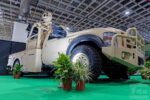At AUSA 2025, Wilcox Industries debuted its new FUSION CLAW system—an open-architecture modular helmet interface designed to integrate sensors, communications gear, and power systems into a streamlined soldier platform. The innovation targets the growing demand for AI-enabled headborne systems in dismounted operations and promises to reduce weight and cognitive burden while enhancing tactical situational awareness.
FUSION CLAW: A Modular Backbone for Next-Gen Soldier Helmets
The FUSION CLAW is a mechanical and electronic interface that consolidates multiple mission-critical subsystems—such as night vision devices (NVDs), augmented reality (AR) overlays, GPS receivers, radios, and environmental sensors—into a single helmet-mounted architecture. Designed with open standards in mind, the system enables plug-and-play compatibility with a wide range of third-party devices via standardized mounts and connectors.
According to Wilcox Industries representatives at AUSA 2025 in Washington D.C., the system supports both legacy analog components and emerging digital/AI-enabled modules. This makes it particularly attractive for militaries transitioning toward integrated soldier systems without having to discard existing inventories.
The core of the system includes:
- A universal mounting rail compatible with standard NVG shrouds
- Integrated power/data bus supporting USB-C and custom interfaces
- Hot-swappable battery modules positioned to balance helmet weight
- Secure cable management channels reducing snag hazards
Enabling Sensor Fusion and Augmented Reality on the Edge
The FUSION CLAW is not merely a physical mount—it is engineered as an enabling platform for edge computing and sensor fusion. By integrating data from EO/IR sensors, inertial measurement units (IMUs), GNSS receivers, and comms nodes directly on the helmet platform, it allows real-time processing of battlefield information at the individual soldier level.
This architecture supports augmented reality overlays such as blue force tracking icons or terrain navigation cues directly within the operator’s field of view when paired with compatible AR optics like Microsoft’s IVAS or Elbit Systems’ X-Sight. The goal is to reduce cognitive load by presenting only relevant data in context-sensitive formats.
Wilcox has emphasized that FUSION CLAW is “AI-ready,” meaning it can host or interface with onboard processors capable of running lightweight neural networks for object detection or threat prioritization. This aligns with broader U.S. Army modernization goals under programs like IVAS Increment II and Nett Warrior refresh initiatives.
Power Management and SWaP Optimization
A recurring challenge in modern soldier systems is managing size, weight, and power (SWaP) constraints while integrating more electronics onto already burdened operators. The FUSION CLAW addresses this by centralizing power distribution through its integrated bus architecture.
The system supports hot-swappable lithium-ion battery packs mounted at the rear of the helmet to counterbalance front-heavy optics. Smart power management firmware prioritizes critical subsystems during low-power states and can interface with external power sources such as body-worn batteries or vehicle charging ports via standardized connectors.
This modular approach helps extend mission duration without significantly increasing loadout mass or complexity—a key consideration for special operations forces operating dismounted over long durations without resupply.
Interoperability with Legacy Systems and Future Tech
One of FUSION CLAW’s standout features is its backward compatibility. Many NATO forces still field legacy NVGs like PVS-14s or AN/PVS-31s alongside newer digital optics; Wilcox’s design accommodates both analog passthroughs and digital data links on a common rail/bus infrastructure.
This ensures that units can gradually phase in advanced capabilities—such as AI-enabled target recognition or AR navigation—without needing wholesale replacement of existing inventory. It also simplifies logistics by reducing SKU proliferation across different mission kits.
The interface is designed according to open architecture principles similar to those used in NATO STANAG-compliant weapon accessories (e.g., Picatinny rails), encouraging third-party vendors to develop compatible modules ranging from thermal imagers to language translation earbuds or facial recognition cameras.
Tactical Implications for Dismounted Infantry Operations
The introduction of modular helmet hubs like FUSION CLAW marks a shift toward fully networked dismounted infantry—a concept long pursued under programs like Land Warrior but now made feasible by advances in miniaturization and edge computing. With such platforms serving as integration points for C4ISR capabilities at squad level, soldiers gain enhanced situational awareness without being overwhelmed by disparate devices or tangled cabling.
This is particularly relevant in urban warfare scenarios where rapid identification of threats from multiple vectors—and coordination between small teams—is critical. By embedding computing power directly into wearable gear rather than relying solely on centralized command nodes or handheld tablets, decision loops are compressed dramatically.
Industry Context: Wilcox’s Expansion into Integrated Soldier Tech
Best known historically for its rugged NVG mounts and weapon accessories used across U.S. SOCOM units, Wilcox Industries has increasingly pivoted toward full-spectrum soldier modernization solutions over the last five years. The launch of FUSION CLAW reflects this evolution from component supplier to systems integrator role within the defense ecosystem.
The company has partnered with several primes—including L3Harris Technologies—for integration testing across multiple platforms including IVAS prototypes. While no formal program-of-record contract has yet been announced as of October 2025, industry observers expect variants of FUSION CLAW may be evaluated under upcoming U.S. Army soldier lethality initiatives or foreign military sales (FMS) channels targeting NATO allies seeking modular C4ISR enhancements at squad level.
Outlook: Toward an Intelligent Edge Soldier Architecture
The unveiling of FUSION CLAW underscores a broader trend toward intelligent edge architectures in military wearables—where compute power migrates from centralized servers down to individual operators equipped with smart optics, secure radios, biometric monitors, and AI processors embedded directly into their gear.
If adopted widely across NATO formations or U.S. Army brigades under future Capability Set upgrades beyond CS25/CS27 timelines, such modular integration platforms could redefine how infantry squads operate in contested environments where bandwidth is constrained but decisions must be made rapidly based on fused sensor inputs.










